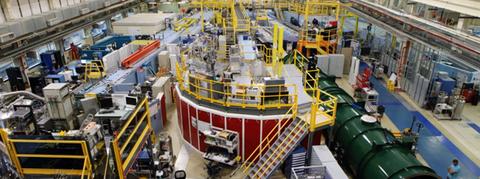Manufacturing

NIST Center for Neutron Research
The CSD provides measurement tools and standards in support of chemical materials manufacturing. These efforts enable and accelerate the design, development, manufacture, and sustainable use of advanced materials; optimization of advanced materials processing; and optimization of production, performance, and reliability of components, devices, and systems that incorporate these materials. The research supports NIST’s mission to promote U.S. innovation and industrial competitiveness in advanced chemical materials, many of which underpin new and improved products and technologies.
Project Areas
-
Advanced IC Interconnects - Process Metrology and Models
-
Determinations of Boron Deposit Quality by Neutron Depth Profiling
-
Measurement Quality in Hydrogen Storage R&D
-
Plasma Process Metrology
Capabilities
The CSD develops and performs physicochemical measurements, theoretical frameworks, and numerical calculations to provide reference data, develop standards, and to advance measurement sciences. Activities include the elucidation of reaction mechanisms, and the measurement of rate constants and transport properties. Experimental methods, measurement standards, and advanced measurement and modeling tools are developed and applied to study chemical transformation found in electronics manufacturing, the aging process of building materials, catalysis, and the environment. CSD maintains SRMs that provide a means to ensure accuracy of measurements and to establish metrological traceability to the International System of Units (SI) and other practical units of measurement.
Customer Outreach
CSD researchers are collaborating with chemical suppliers and deposition equipment manufacturers. CSD is examining the performance of commercial precursor delivery systems to enable more reproducible delivery of reactants (organometallic, organosulfur, and metal halide compounds) used in atomic layer and chemical vapor deposition processes by the microelectronics industry. CSD is also engaged with industry to characterize the chemical mechanisms operative during commercial deposition processes to facilitate optimization of thin-film growth recipes for key materials such as transition metal dichalcogenides for 2-D electronic materials, metal films for interconnects, and high-κ metal oxides for gate dielectrics.
Achievements and Impact
CSD has developed a high-sensitivity optical mass flow meter to characterize commercial precursor delivery systems and has used this instrumentation to develop validated precursor delivery models. Precursor vessel designs for solid and liquid precursors as well as pressure- and flow-based delivery control strategies have been studied. Analytical models and more sophisticated computational fluid dynamics-based models provide insight into important underlying physical mechanisms. With these results, delivery systems can now be characterized in terms of different figures of merit (e.g., efficiency, stability, reproducibility, and quantity) and thereby facilitate efficient process development.
To understand underlying deposition mechanisms, CSD continues to develop and apply in situ surface sensitive optical diagnostics coupled with research-grade single wafer reactors. Construction of a research-grade high-temperature single-wafer reactor with flexible diagnostic access was recently completed. Time-resolved, reflection absorption infrared spectroscopy has been utilized to investigate deposition chemical mechanisms for Al2O3 and La2O3, high-κ metal oxides, using commercially relevant precursors. The reaction kinetics for Al2O3 deposition were measured, resulting in a new kinetic model. The surface species during La2O3 deposition were identified, resolving an uncertainty in the primary deposition processes in different temperature windows. In situ spectroscopic ellipsometry has been used to study six precursors, identifying process conditions that favor self-limiting growth of MoS2 films while avoiding thermal decomposition reactions. Optical models were developed to obtain deposition rates and were subsequently validated by ex situ X-ray reflectivity. Investigations of metal film deposition have focused on the evaluation of a novel reducing agent for low temperature processes.
Technology and Knowledge Transfer
CSD staff serve on a wide variety of standards development organizations (SDOs). Within the framework of ASTM International, these include Committee E37, Thermal Measurements, and Committee E01, Analytical Chemistry for Metals, Ores, and Related Materials. CSD staff are partnering with industry including chemical suppliers and deposition equipment manufacturers to develop and apply new in situ measurement capabilities to facilitate the optimization of advanced commercial ultrathin film deposition processes. CSD continues to work with industry to evaluate precursor delivery and control methods. Much of the knowledge transfer was facilitated by CSD hosting industrial guest researchers and regular engagement.
Selected Publications
-
B.A. Sperling, B. Kalanyan, J.E. Maslar. “Atomic Layer Deposition of Al2O3 using Trimethylaluminum and H2O: The Kinetics of the H2O Half-Cycle”. J. Phys. Chem. C., 124(5), 3410 (2020). DOI: 10.1021/acs.jpcc.9b11291.
-
J. E. Maslar, W. A. Kimes, B. A. Sperling and R. K. Kanjolia. "Non-dispersive infrared gas analyzer for partial pressure measurements of a tantalum alkylamide during vapor deposition processes". Appl. Spectrosc., (2019). DOI: 10.1177/0003702819885182
-
B. A. Sperling and J. E. Maslar. "Experiment-based modeling of a vapor draw ampoule used for low-volatility precursors". J. Vac. Sci. Technol. A, 37(6) (2019). doi: 10.1116/1.5125446.
-
J. E. Maslar, W. A. Kimes, B. A. Sperling and R. K. Kanjolia. "Characterization of bubbler performance for low-volatility liquid precursor delivery". J. Vac. Sci. Technol. A, 37(4), 041506 (2019).
doi: 10.1116/1.5099264.
-
J. E. Maslar, W. A. Kimes and B. A. Sperling. "Apparatus for characterizing gas-phase chemical precursor delivery for thin film deposition processes". J. Res. Natl. Inst. Stand. Technol., 124, 005 (2019). doi: 10.6028/jres.124.005.
-
B. Kalanyan, R. Beams, M. B. Katz, A. V. Davydov, J. E. Maslar and R. K. Kanjolia. "MoS2 thin films from a (NtBu)2(NMe2)2Mo and 1-propanethiol atomic layer deposition process". J. Vac. Sci. Technol. A, 37(1), 010901 (2019). doi: 10.1116/1.5059424.
-
A.R. Montoro Bustos, K.E. Murphy and M.R. Winchester, “Evaluation of the potential of single particle ICP-MS for the accurate measurement of the number concentration of AuNPs of different sizes and coatings,” Anal. Chem., 94(7), 3091-3102 (2022).

